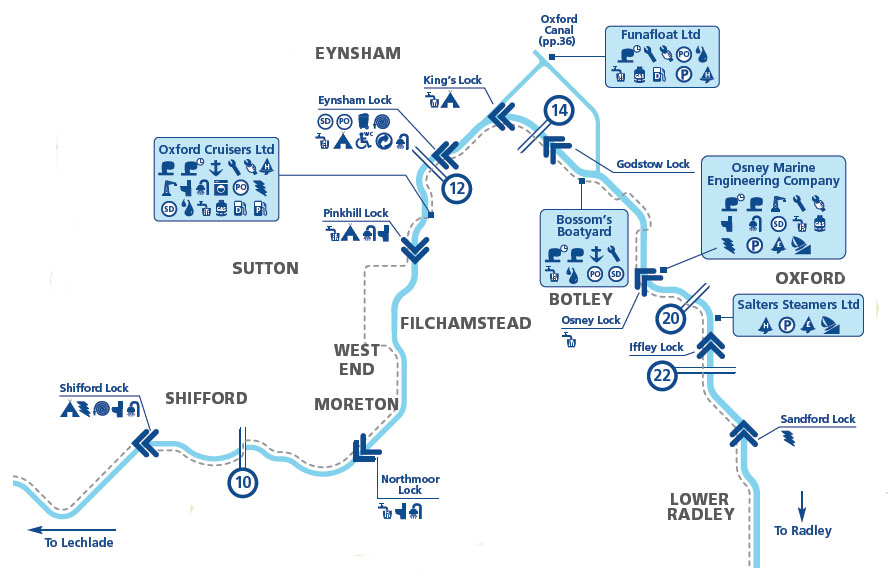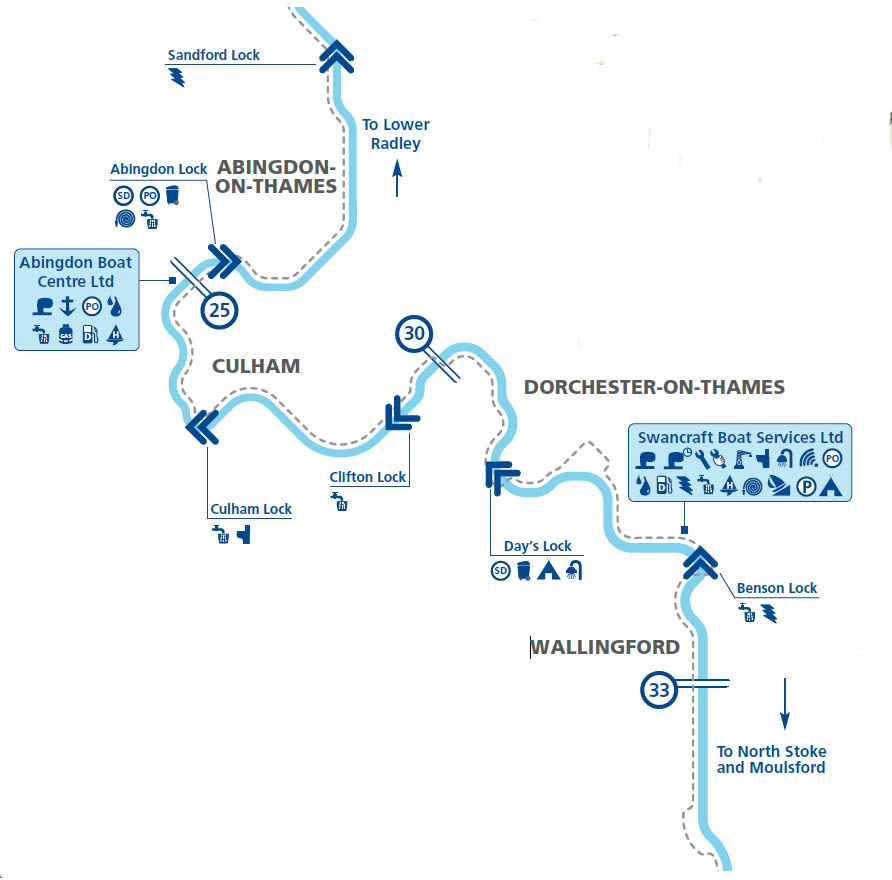RIGHT bank, tel:01865 775889, length: 174'0", width: 21'9"
Camping above Sandford Lock, 01865 244088
Kings Arms, Sandford, RIGHT bank immediately above lock. Good moorings for customers.

Sandford Lock.
Seen from below with a very high water level and Red Board Warning
Sandford Hydro
Opened in 2017. This is community owned through the Low Carbon Hub in Oxford. Three Archimedes screws are within this 450KW hydro scheme across the river At Lasher Weir by Sandford Pool.
The ancient Thames navigation channel at Sandford was that which now forms the western stream, now known as the backwater.
At the northern end where now stands the Big Lasher, stood the old navigation or flash weir, described in 1624 as 'Great Lockes'.
Passage through these locks was always difficult and dangerous, the process of removing paddles from the lock
and either pulling or hauling boats through against the strong stream, or riding the flash on the downstream journey.
Such a lock meant a great loss of water often leaving the upper reaches dry or low in water for days, boats then having to wait
until the water had risen again enough for further passage.
Clearly with the increase in traffic, these conditions could not continue as not only was the water-borne traffic slowed down - perhaps for days on end,
it also caused the mills on the river to cease working, due to lack of water.
Under the Oxford and Burcott Commission, the modern Pound Lock, having upper and lower mitre gates, was introduced to the Thames,
firstly in three places:- Swift-ditch near Abingdon, Iffley, and Sandford, which was probably the first around 1632.
The site of this old lock has now been filled in, but its position can still be seen alongside the present lock.
Originally it was 87 ft in length but in 1793 was lengthened to 120 ft.
If one looks on the upstream side of the footbridge, the position of the upper gates can still be seen in the stonework.
A new lock on the present site was opened in September 1936 and it was much the original structure
that was removed to build our present lock in 1972 - 1973.
A SANDFORD TIMELINE
| WEIR STREAM | LOCK HOUSE | MODERN LOCK | LOCK SIDE | OLD LOCK | LEFT BANK |
| - 1294 - FLASH LOCK |
- | - | - 1294 - Mill |
- | - |
| FLASH LOCK | - | - | Mill | 1632 - POUND LOCK |
- |
| FLASH LOCK | - | - | Mill | 1793 - LOCK lengthened |
- |
| FLASH LOCK | 1790s Belanger Picture - | ||||
| FLASH LOCK | - | - | - | LOCK | 1824 - MILL REBUILT LEFT BANK - |
| - 1836? - LASHER |
- | 1836 - LOCK IN MODERN POSITION |
- | - OLD LOCK | - MILL - |
| - LASHER - | 1839 - LOCK HOUSE |
LOCK | - | LOCK disused | - MILL - |
| - LASHER - | LOCK HOUSE | LOCK | - | LOCK disused | 1875 MILL FIRE |
| - LASHER - | LOCK HOUSE | LOCK | - | 1881 - MILL EXTENSION over 1632 lock |
1881 MILL REBUILT |
| - LASHER - | 1914 - NEW LOCK HOUSE |
LOCK | - | MILL | MILL |
| - LASHER - | LOCK HOUSE | 1972 - LOCK REBUILT |
- | MILL | MILL |
| - LASHER - | LOCK HOUSE | LOCK | - | FLATS | FLATS |
Fred Thacker, The Thames Highway, Volume 2, Locks and Weirs, 1920
Order changed to date order -
1294: Sandford Mill built by the Knights Templar.
1294?: Henry, son of Adam the ferryman, grants the ferry to John Golding of Newnham, and Scolastica his wife.
1327-1377: An early instance of the immemorial disputes between the mills and the water traffic is recorded by Anthony a Wood as having occurred
under Edward III; when "the men of Oxon broke down the locks of Sandford which 'the brethren' there raised".
This is my earliest allusion to the flashlock; built by the preceptory, doubtless for the benefit of the mill; to the enragement of the bargemen of Oxford.
1348 & 1361: the Ferry was part of a fee for masses in Witney Church.
1506: Wm. Bushe appointed as the ferryman in room of Thos. Hunt, deceased.
1514: Wm. Bushe noted as the ferryman.
1520: the "mill and the fishweir called the lok" were let for £12 yearly.
1530: John Dale appointed ferryman.
1585: Bishop - "Samford Lock kept by John Ovens". [In Volume 1, p.56 is added "The Locke in the P ish [Parish] of Kennington" i.e. this was a flash lock on
what we now know as the weir stream on the LEFT bank perhaps near the modern lasher]
1632: As I have remarked under Iffley, the poundlock here was one of the the three installed by the Oxford-Burcot Commission;
and therefore one of the first three on the river. I cannot fix its completion earlier than 1632, when John Taylor
mentions it in his rhymed survey of the River.
1639: Edmund Powell was in charge of it for the Commission; under whose authority it remained until their works were sold in 1790.
1761: John Rocque's map of Sandford and Iffley -

John Rocque, 1761
1767: The pound was rented by Mrs. Hill;
1780: [The pound was rented ] by Beckley;
1791: the weir belonged to another Hill [see 1767]. At Michaelmas this year Beckley paid fifteen guineas for one year's rent of the lock. A puny amount ...
1790s: Sandford Hill, Louis Belanger -

Sandford Mill, Louis Belanger
NB The title is Sandford HILL and the subscription Sandford MILL
Fred Thacker, The Thames Highway, Volume 2, Locks and Weirs, 1920
Order changed to date order -
1793: It was decided to lengthen the lock from 87 to 120 ft.
1794: it was reported that "the walls of the lock appear to be blowing away, and the whole work is in a very dangerous
and precarious situation". So probably nothing had been done.
1795: Things being "worse than ever" rebuilding was immediately started.
Harris "the Oxford gaoler", having charge of the work.
The expense was nearly £1800, and the criticism was made that a less sum would have built a new lock in a better situation.
The passage was stopped for a year;
"and the navigators obliged to change boats and shift their cargoes over the meadows or shoot the old flash Lock at very great risk;
one boat being sunk in the experiment."
1796: Bickford or Beckley (perhaps the man named in 1780 and 1791) was the first keeper named under the Thames Commissioners.
He stayed untill at least 1798.
1810: Danby the Iffley Miller succeeded [Bickford] before 1810; with the same privilege as at Iffley with respect of pleasure tolls.
1818: [Danby] died in or before Novemeber 1818; and Thomas Day had his place.
1821 & 1822: H Swann the miller had charge at 36s. monthly remuneration.
1824: The mill was rebuilt about 1824.
1826: the lock is described as having a fall of "about 7 feet".
1836: A new lock, on the present site, was opened in September 1836 alongside the old Jacobean structure.
1838: The City of London committee reported very warmly in its praise:
"in place of the old decayed and shallow lock, impassable at low water seasons without large and frequent flashes.
1839: A lockhouse was ordered in October 1839.
1842: Wm. Haines (possibly of the Old Windsor family) was keeper in 1842.
1846: J. Swann is named as weir owner.
1850: In a sale catalogue of the property dated August 1850, paper is indicated as the product of the mill.
The freehold tolls of the "old lock" (flash) are stated to have produced an average of £200 annually during the previous ten years.
1854: A press cutting of December 1854, referring to the Abingdon branch railway line, then being inaugurated, reads'
"It is reported that Mr. Norris has personal motives for decrying this railway.
As lessee of Sandford Lock he will lose £100 a year toll when the railway is open."
This is probably J.T.Norris, of Sutton Courtenay also. I do not know how he comes to be located at Sandford,
unless he had the mill and was financing Wyatt; whom the official records name as lessee of the lock at this date.
1861: Ravenstein paid his usual 6d. here in 1861.
1865: At the parliamentary inquiry of 1865 it was stated that here "was a lock some years ago
which was given up, and the millowner had very indiscreetly opened the
sluice of this lock, allowing the water to rush through with tremendous
force, and allowed the water to undermine the embankment between that
lock and the next"; i.e. between the old pound and the new one beside it.
1866-1877: The iron bridge over the main stream above the lock was built between 1866 and 1877.
1870: Taunt picture of Sandford Mill

Sandford Mill 1870
1870: Taunt picture of Sandford Lock

Sandford Lock 1870
1870s: [The Mill] had been burnt down two or three years earlier [than 1877] and rebuilt, the head being raised from five to nine feet. At that time it made paper for the Clarendon Press; but ruined everybody that has ever come to it. It is the real fall of the Thames; and when there is a flood it is grand to see the fall.
1875: Taunt picture of the ruined mill after the fire.

Sandford Mill in Ruins after the 1870s fire
Fred Thacker, The Thames Highway, Volume 2, Locks and Weirs, 1920
Order changed to date order -
1880: The part of the mill astride [the old pound] was built in 1880.
1881: In February the Clarendon Press, having bought the mill, asked to buy the old pound for an extra wheel.
It was still to be seen in 1913, in site, though not in actual masonry, identical with the James I
work.
1882: Sandford Mill and Lock, Henry Taunt -

Sandford Mill and Lock, Henry Taunt, 1882
© Oxfordshire County Council Photographic Archive;
1894: Sandford Mill and Lock, Henry Taunt -

Sandford Mill and Lock, Henry Taunt, 1894
© Oxfordshire County Council Photographic Archive;
1895: Sandford Lock and Bridge, Henry Taunt -

Sandford Lock and Bridge, Henry Taunt, 1895
© Oxfordshire County Council Photographic Archive; HT210
1914: The current lock house was built -

Sandford Lock House
1955: Sandford Lock, Francis Frith -
1972-3: The lock was
reconstructed. It was the first of a series of locks built with an
underfloor filling system.
1973: Plaque on the RIGHT bank lock wall downstream of the bottom gates -
CONSERVATORS OF THE RIVER THAMES
This plaque was unveiled on the 2nd June 1973 by
THE LORD NUGENT OF GUILDFORD R.S.
Chairman of the Conservators
in the presence of
the Chairman of Oxfordshire County Council
ALD. THE RT.HON THE VISCOUNTESS PARKER
To commemorate the reconstruction of
SANDFORD LOCK




